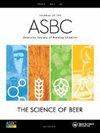农艺重要次生代谢物的基因表达。美国农业部级联啤酒花(Humulus lupulus L.)关键发育阶段的锥体
IF 1.8
4区 农林科学
Q4 BIOTECHNOLOGY & APPLIED MICROBIOLOGY
Journal of the American Society of Brewing Chemists
Pub Date : 2021-10-26
DOI:10.1080/03610470.2021.1973328
引用次数: 2
摘要
摘要对啤酒花(Humulus lupulus) c.v. ' Cascade)锥体组织中三个发育阶段(早期、中期、晚期或近收获期)的狼疮素腺和相关苞片的转录组进行了测序。在球果发育的中期,许多与苦酸、黄腐酚和挥发性次生代谢物或“啤酒花油”的生物合成有关的基因的表达模式显著增加。啤酒中流行的“热带水果”风味的硫醇前体的生物合成尚不清楚,但假设参与这一过程的基因同源物在啤酒花锥的后期往往被上调。需要更多的研究来描述啤酒花中硫醇前体生物合成的途径。分层聚类揭示了从每个发育阶段采集的样品的重叠,可能是由于植物上球果的不均匀成熟。有人提出,酒花中产生重要风味的次生代谢物的关键是球果发育的中期,这一观点得到了先前关于次生代谢物浓度的研究的支持。据推测,锥体发育中期的非生物胁迫可能对啤酒花中最终发现的苦味酸浓度非常有害。本文章由计算机程序翻译,如有差异,请以英文原文为准。
Gene Expression of Agronomically Important Secondary Metabolites in cv. ‘USDA Cascade’ Hop (Humulus lupulus L.) Cones during Critical Developmental Stages
Abstract The transcriptome from lupulin glands and associated bracts from cone tissue of hop (Humulus lupulus) c.v. ‘Cascade’, during three stages of development: early, mid, and late or near-harvest, was sequenced. Significant increases were found in expression patterns of many genes involved in the biosynthesis of bitter acids, xanthohumol, and volatile secondary metabolites or “hop oils” during the middle stage of cone development. The biosynthesis of thiol precursors responsible for popular “tropical fruit” flavors in beer is not well known, but homologs of genes hypothesized to be involved in this process tend to be up-regulated during the late stage in hop cones. More research needs to be performed to describe the pathway of thiol precursor biosynthesis in hops. Hierarchical clustering revealed overlap of samples taken from each developmental stage, likely due to non-uniform ripening of cones on the plant. It is proposed that the mid-stage of cone development is critical for the development of important flavor-producing secondary metabolites in hops, and this is supported by previous research describing concentrations of secondary metabolites. It is hypothesized that abiotic stress during the mid-stage of cone development may be quite detrimental to the bitter acid concentrations ultimately found in hops.
求助全文
通过发布文献求助,成功后即可免费获取论文全文。
去求助
来源期刊

Journal of the American Society of Brewing Chemists
工程技术-生物工程与应用微生物
CiteScore
4.00
自引率
20.00%
发文量
41
审稿时长
3 months
期刊介绍:
The Journal of the American Society of Brewing Chemists publishes scientific papers, review articles, and technical reports pertaining to the chemistry, microbiology, and technology of brewing and distilling, as well as the analytical techniques used in the malting, brewing, and distilling industries.
 求助内容:
求助内容: 应助结果提醒方式:
应助结果提醒方式:


